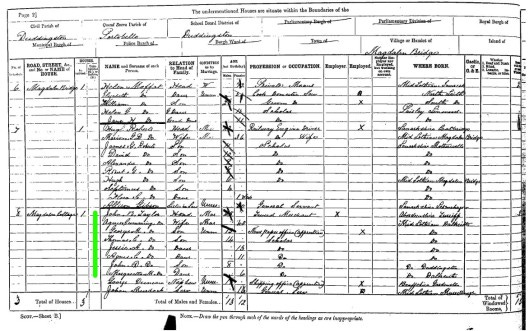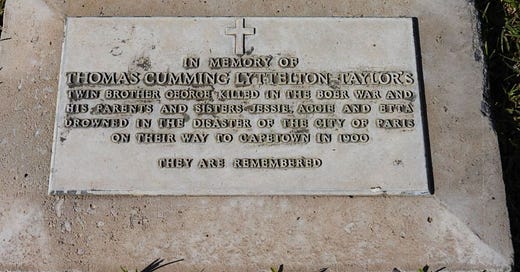About a year ago I came across a photograph of a plaque in Lincoln Grove Evergreen Memorial Park, Tamworth, New South Wales, which read:
In Memory of Thomas Cumming Lyttelton-Taylor’s Twin Brother George Killed In The Boer War
And His Parents And Sisters Jessie Aggie And Etta Drowned In The Disaster of The City of Paris On Their Way To Capetown In 1900
They Are Remembered

The plaque is associated with Thomas Cumming Lyttelton-Taylor who died 22 September 1966.
Apart from his death date, 22 September 1966, I didn’t know anything about Thomas Cumming Lyttelton-Taylor. I found the index to the death registration of Thomas in 1966 in Tamworth, New South Wales, which told me he was the son of John Barelay and Elizabeth Cumming. A marriage notice in the Sydney Morning Herald of 24 June 1942 helped a bit more:
Quiet Wedding
The marriage took place very quietly in Sydney of Mrs. McEvilly-Jordan, eldest, daughter of the late Mr. Charles Regan, of Tamworth, and of Mrs. Regan, of Vaucluse, to Mr. T. C. Lyttelton Taylor, of Sydney and London Mr. Taylor's nearest living relative is his cousin, Sir Patrick Duncan, present Governor-General of South Africa. The bride is related through her father to both sides of the family of Captain Hamilton O'Malley, who married recently the King's second cousin, Lady Iris MountbattenThis was useful, but I was puzzled about the drownings in the wreck of the ‘City of Paris‘. Who were these people?
The City of Paris, was a British-built passenger liner of the Inman Line that held the Blue Riband as the fastest ship on the north Atlantic route from 1889 to 1891 and again from 1892 to 1893. In 1893, she was renamed Paris. In 1899 she was seriously damaged when she grounded on The Manacles, a set of treacherous rocks off The Lizard peninsula in Cornwall.

Although the ship was badly damaged she was refloated, rebuilt and resumed service in 1901.
The ‘City of Paris‘ connection came to a dead end though, for I could not find any record of anyone drowning in the shipwreck, certainly not a family of five. I searched for other shipwrecks and for death and probate records for the family. Nothing
Anyway, after creating profiles—rather empty—on Wikitree I put the whole thing on the back burner, and there it remained, until Wikitree’s new ‘Content Rank’ rating scheme flagged the profiles as a bit thin and unsupported, so I was prompted to look for more information about the family.
Approaching the research again a few days ago eventually I got onto the family through persitant searching of indexes on ancestry.com. I came across a census record for a family whose names matched those on the plaque. I found a George and Thomas, apparently not twins though, a Jessie, Agnes (could be Aggie) and a Margaretta (could be Etta). The index for Thomas’s death registration had indicated his parents were John Barely and Elizabeth Cumming. The father’s name matched and the mother shared the correct middle name. There was also George Duncan, a nephew of John, whose family name fitted the notable cousin, Sir Patrick Duncan GCMG KC (1870-1943) mentioned in the 1942 marriage notice.

Having found the family I began to research its members.
Thomas served in the Boer War, but not George. Thomas emigrated to Australia and had arrived by 1914. He was married twice. No member of the family died in a shipwreck. Thomas’s father, John Barclay Taylor died in 1908. Thomas’s mother, Agnes Bennett (Cumming) Taylor, died in 1911. His sisters died in 1949, 1957, and 1966. His brother George, not his twin, died in 1955. At the time of his 1942 marriage he had four siblings still alive. I did confirm that Sir Patrick Duncan was indeed Thomas’s first cousin; Sir Patrick’s mother was the sister of Thomas’s father.
Whoever erected the plaque in Tamworth—it was probably Kathleen, Thomas’s wife—was, consciously or not, passing on a mess of misinformation. My guess is that Thomas, estranged from his family, told his wife they they were all dead, drowned in a shipwreck.
I don’t know when or why Thomas adopted the surname Lyttelton-Taylor.
There is no family connection, so how did I get involved? You’d never guess. Thomas’s wife Kathleen lent a collection of antiques to the Australian National University. I’d heard about it through one of my Canberra relatives.
What a yarn! Thank you ‘Content Rank’ for encouraging me to connect the dots.
Wikitree:
Thomas Cumming (Taylor) Lyttelton-Taylor (1877-1966)
Kathleen McEvilly (Regan) Lyttelton-Taylor (1895-1984)
John Barclay Taylor (1844-1908)
Agnes Bennett (Cumming) Taylor (abt.1851-1911)
George Morrison Taylor (1875-1955)
Jessie Anderson Taylor (1878-1949)
Agnes Cumming Taylor (1879-1957)
Margaretta Morrison (Taylor) Riley (1884-1966)
This post first published at https://anneyoungau.wordpress.com/2025/06/23/brasses-and-antiques/


I applaud your curiosity a s tenacity, and yes, what a story! Wouldn’t it be wonderful to actually know what was behind the plaque and all its misinformation?
That is fascinating. I wonder what prompted the error. A great reminder though that good evidence usually requires a range of information not one single item.